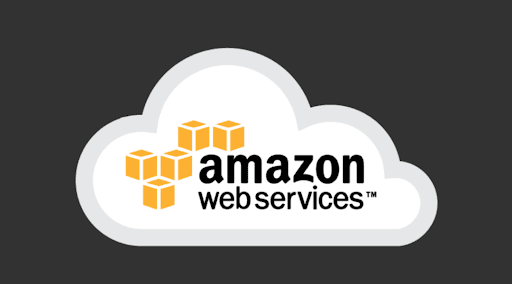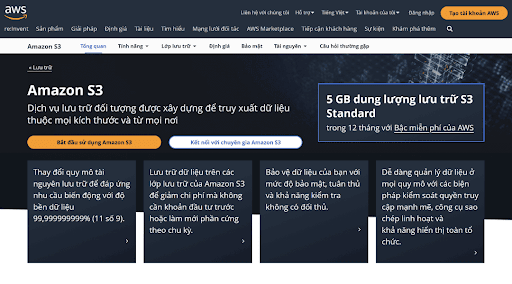
What is AWS? The secret to optimizing costs with Amazon Web Services
What is AWS and Why Has Amazon Web Services Become the Top Choice for Businesses in the Digital Era? This article analyzes popular services, reasons for rising costs, and provides solutions to optimize investment efficiency in cloud infrastructure.
1. What is AWS? Discover Why Businesses Trust Amazon Web Services
In the context of rapid digital transformation, understanding what AWS is has become essential for businesses seeking to optimize infrastructure and enhance operational efficiency. As the leading cloud computing service of Amazon Web Services, AWS is trusted by millions of organizations worldwide for its flexibility, security, and cost-efficiency.
1.1. Definition of AWS (Amazon Web Services)
AWS (Amazon Web Services) is a comprehensive cloud computing platform developed by Amazon, offering over 200 services including storage, data analytics, artificial intelligence (AI), security, and machine learning (ML).
Unlike traditional infrastructure, AWS allows businesses to deploy applications, store, and process data in a cloud environment using the “pay-as-you-go” model. This significantly reduces the cost of investing in physical servers while offering scalable flexibility based on actual needs.

With data centers distributed worldwide, Amazon Web Services ensures fast access speed, high stability, and strict security standards such as ISO 27001 and SOC 2 compliance.
1.2. Key Advantages of AWS for Businesses Today
Developed by a leading global technology corporation
Built by Amazon — a global leader in innovation — AWS inherits its strong infrastructure, high-level engineering expertise, and strategic vision. As a result, the platform continuously expands its scale and enhances performance, enabling millions of businesses worldwide to operate flexibly and securely in the digital environment.
Global data center network with superior performance
AWS owns a network of data centers across key global regions, providing high-speed processing, strong stability, and flexible scalability. This large-scale infrastructure ensures that enterprise data is stored, backed up, and accessed from desired locations with optimal security.
Multi-layered security with world-class safety standards
Compared to traditional server models, Amazon Web Services stands out with its multi-layer security mechanisms, comprehensive data encryption, and proactive monitoring system. Combined with international compliance certifications, AWS provides a reliable operating environment, giving businesses peace of mind from storage to application deployment.
With its combination of advanced technology, top-tier security, and robust global infrastructure, AWS has become a trusted platform for millions of businesses. Understanding what AWS is not only helps optimize costs but also empowers companies to advance further in their digital transformation journey.
2. Popular Services on Amazon Web Services
Amazon Web Services not only provides cloud infrastructure but also offers a comprehensive ecosystem of services that help businesses optimize operations, security, and costs. Among them, Amazon EC2, Amazon S3, and AWS Lambda are considered three of the most widely used solutions, enabling efficient business operations.
2.1. Amazon EC2 – A Flexible Virtual Server Solution
Amazon EC2 (Elastic Compute Cloud) allows businesses to rent and manage virtual servers as needed, enabling flexible resource scaling without costly hardware investment.

Its strengths lie in customizable configurations, integrated security, and seamless connectivity with other AWS ecosystem services. Businesses that effectively leverage EC2 can significantly enhance operational performance while maintaining long-term cost optimization.
2.2. Amazon S3 – Secure and Scalable Data Storage
Amazon S3 (Simple Storage Service) is the core storage solution within the Amazon Web Services ecosystem, allowing businesses to store, back up, and retrieve data at any scale. According to AWS, S3 is designed with 99.999999999% durability, ensuring near-absolute data safety and integrity.

The strengths of Amazon S3 include scalability, high availability, and deep integration with other AWS services. Businesses can manage petabytes of data while maintaining fast, stable access speeds. With AWS-certified technical teams, organizations can fully utilize management features, optimize costs, and ensure compliance with global security standards.
2.3. AWS Lambda – Intelligent Automation with Maximum Efficiency
AWS Lambda is a serverless computing service that allows code execution without managing infrastructure. Businesses only pay when the code runs, minimizing operating costs. Lambda is particularly suitable for event-driven applications such as log analysis, automated system responses, or real-time data integration.

When integrated with other Amazon Web Services tools, AWS Lambda enables businesses to build intelligent, automated, and flexible operational models. This helps technical teams reduce workloads, allowing more focus on core development and long-term innovation strategies.
Choosing the right combination of AWS services allows businesses to operate systems that are stable, secure, and easily scalable. Applying the right strategy also helps optimize costs and build a solid foundation for sustainable growth in the cloud era.
3. Reasons Why AWS Costs Can Rise
Amazon Web Services is widely trusted for its scalability and high security. However, operational costs can rise significantly if not managed carefully. To optimize budgets, businesses need to identify the common causes of cost increases.
3.1. Overprovisioned Resources Beyond Actual Needs
One of the main reasons AWS costs rise is selecting configurations that exceed actual requirements. When businesses create multiple EC2 instances with higher CPU or RAM capacities than necessary, expenses increase rapidly. This often happens when companies over-provision resources for potential traffic spikes while average usage remains low.
To address this, businesses can apply Auto Scaling and regularly analyze usage patterns. This approach ensures efficient operations, allowing the system to scale resources dynamically while proactively optimizing costs.
3.2. Inefficient Data Management and Storage
AWS costs can also rise due to poor data management. A common mistake is storing infrequently accessed data in the Amazon S3 Standard class instead of cost-saving options like S3 Glacier or S3 Intelligent-Tiering. This increases expenses significantly without adding value.
Moreover, failing to clean up outdated data or lacking lifecycle management strategies can lead to unnecessary storage costs. AWS-certified technical teams can implement intelligent storage policies, properly tier data, and optimize costs without compromising performance.
3.3. Underutilization of Cost Management Tools
Amazon Web Services offers comprehensive cost management tools such as AWS Cost Explorer, Trusted Advisor, and AWS Budgets. However, many businesses overlook these tools, making costs harder to control and often facing unexpected charges at billing time.

To maintain financial stability, businesses should train their technical teams to monitor, forecast, and set cost alerts to optimize resource usage. Additionally, taking advantage of programs like Reserved Instances or Savings Plans can help significantly reduce expenses while maintaining high performance in the AWS ecosystem.
High AWS costs often stem from overprovisioned resources, inefficient data management, and lack of cost monitoring. Businesses with optimization strategies and skilled technical teams can manage expenses effectively and maximize the benefits of AWS.
Explore now: Amazon Prime Day 2025: The Unmissable Sales Surge Event
4. Tips to Help Businesses Optimize AWS Costs
During digital transformation, many companies adopt Amazon Web Services as their core infrastructure. However, cost management remains a major concern. The key lies in managing resources, selecting appropriate service plans, and strategically leveraging available tools.
4.1. Using AWS Cost Explorer and Trusted Advisor
The two AWS cost management tools — Cost Explorer and Trusted Advisor — are essential for businesses to monitor and forecast expenses accurately. Instead of reacting to bill surges, organizations can proactively track resource usage trends and optimize budgets in real time.
Cost Explorer offers a visual breakdown of service consumption by account or project, allowing teams to detect anomalies and adjust configurations promptly. Meanwhile, Trusted Advisor acts as an automated “technical assistant,” providing recommendations on performance, security, and cost-saving opportunities.
When used together, these tools not only minimize resource waste but also strengthen financial management processes in the cloud environment — a vital step toward improving forecasting capabilities and maintaining budget control.
4.2. Optimizing Resources and Selecting Suitable Service Plans
To control AWS costs, businesses must assess their usage needs carefully and choose suitable resource models. Instead of maintaining large fixed configurations, organizations can combine models like Reserved Instances, Spot Instances, or Savings Plans to maximize cost efficiency.
Reserved Instances are ideal for stable workloads, while Spot Instances are suitable for flexible, non-continuous tasks. Savings Plans offer significant discounts while retaining flexibility in service deployment.
Additionally, Auto Scaling automatically adjusts resources based on real-time demand, preventing both underutilization and overcapacity. Combined with intelligent storage tiering strategies, businesses can balance performance and cost — maintaining operational stability while keeping AWS expenses at optimal levels.
4.3. Training Employees with AWS Certifications for Better Management
A technical team equipped with AWS certifications provides a solid foundation for efficient system management. In-depth expertise enables them to design, monitor, and adjust systems based on actual needs, reducing waste and enhancing operational efficiency.
Investing in employee training allows teams to manage systems proactively, predict and resolve issues, and optimize costs throughout the company’s growth stages. This is a long-term investment that strengthens sustainability and financial efficiency in digital transformation strategies.
Optimizing AWS costs is not about random cuts but rather intelligent management based on data, experience, and long-term strategy. When businesses effectively use monitoring tools, choose the right plans, and build capable teams, costs remain tightly controlled and become a sustainable competitive advantage.
Learn more: What is AWS? Key Features and Core Services of Amazon Web Services
5. Optimizing AWS Costs – A Smart Move for Businesses
As cloud computing becomes a core part of business infrastructure, optimizing AWS costs is not just a money-saving tactic but a long-term investment strategy. Poor cost management can quickly increase financial burdens due to hidden fees from unused or poorly stored resources.
To control expenses effectively, businesses should combine several measures such as using AWS Cost Explorer, selecting appropriate service plans, and developing AWS-certified technical teams to ensure long-term system stability and efficiency.
AGlobal – The best cross-border eCommerce solution for your business.
Register now for a free 1-on-1 consultation tailored to your industry needs Here!
